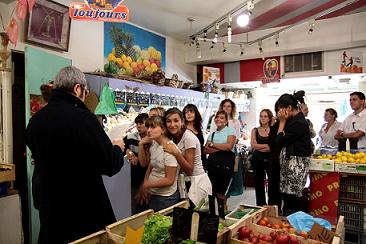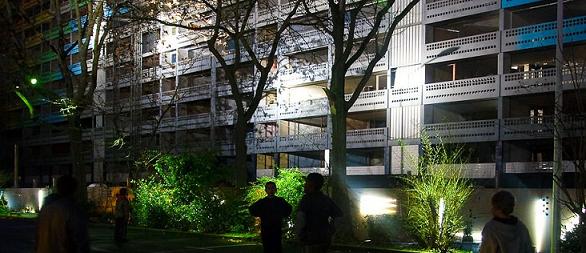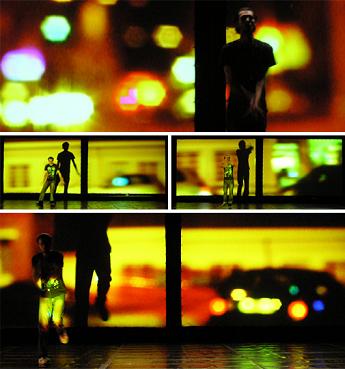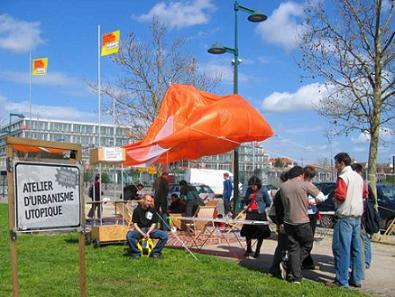THE ROLE PLAYED BY LOCAL PEOPLE IN THE ARTISTIC CREATIVE PROCESS - DEC. 2008/FEB. 2009
The inclusion of the local people in the act of artistic creation is a recurrent aspect of the project spaces represented in ARTfactories/Autre(s)pARTs. This manner of doing things is emblematic of a way of seeing the role of art and culture in our society. The contributors discussed the specific features of their own creative processes, between the declared aim of legitimacy and the need for recognition.

â–ºBRIEF SUMMARY
A multitude of projects

The local people play many different types of role in the artistic creative process. Their role is specific to each project, and it would be contradictory to propose one single method or definition of the right or wrong role to be played by them. Their role is devised according to the various different partners and the “territory†[1] concerned, as well as the involvement of each of them. Defining a “correct†role would amount to denying the specific nature of this type of approach to artistic creation, which is experimental by its very nature. Note nevertheless that there are some common points between all the practices reported during this workshop. Artists call upon the local people’s real-life experiences – in brief, their singularity – on which the artistic creative process will be based. By collecting the spoken word and personal objects or providing certain equipment and resources (such as a video camera, audio recorder, etc.), the local people are asked to contribute in their own right in order to reveal or bring out the basic subject matter of the project.
Therefore some of this subject matter is pre-existing, as are the “territories†, the cultural, social and educational organisations, and the private and collective histories with which the artist works during a period (which may vary from a few days to a few months, or sometimes even several years). Among other things, it becomes the catalyst for updating or reviving a forgotten or ignored culture of which the local people are the first witnesses and the first players. For example, it can highlight the shared history of a building that is condemned to be demolished, a neighbourhood that is being redeveloped or, more modestly, of buildings that a person wishes to get rid of. In all cases, there is the same intention of highlighting the qualities of the local people and their “territory†, not according to an order of moral values but in their own right, that is, as singular expressions of an interaction between individual cultures and collective representations. As one contributor to the workshop said: “The aim is to get as close as possible to the local people†. Of course, such artistic creative processes do not aim to provide answers for a particular situation but to question the relationships – which are often not thought-out, sometimes frictional, and always significant – that exist between individual cultures and collective representations.

The work of art as a process
In this context, the act of artistic creation is similar to a process. It may result in a show, a concert or a public production, but this is not its end purpose. It is the creative process itself which constitutes the work, and which requires specific organisation. Every project is jointly constructed with all partners – constructed really jointly, otherwise it is sure to result in failure, that is, in the lack of interest shown by the local people or the manipulation of the artist. Furthermore, whatever the number of partners, it is fundamental for the project initiators to avoid face-to-face interaction between the artist and the local people, which can become sterile, or even harmful, considering the sensitive subjects addressed in this type of project. Therefore preparation and follow-up are vital for an artistic creative process that includes the local people. These two very technical aspects require a lot of time and care (for preparing documents, meetings, and continual ongoing communication, publicity and information, etc.) but also thorough thought and analysis. The contributors all agree that their action should be described as political, in the sense that it is artistically linked to the way people live together. Such action is all the more difficult since it often creates a new interface between sections of the population, institutions and elected representatives – with all the issues that this entails.
 The links established in this way between the people constitute one of the main specific features of artistic creative processes referred to during this workshop. Fundamentally, the local people and the artist are all in the same boat, and they are all jointly subjected to the effects of this process. The artist’s way of doing things is questioned during the project according to the people’s reactions, their involvement and what the “territory†and the local people will reveal under the action of the artistic work. This was reflected in the subtle distinction made by one contributor between the works created from people and the works created with them. Having said so, the artist and the local people have distinct roles, and it is important to not confuse them. While it is marked by the experience of local people, the work (or the process) produced retains the artist’s mark and subjectivity. It reflects a formal applied creative process, which depends on the local people, but the artist has responsibility for it and, finally, is conscious of it. In turn, the local people see a reflection of themselves created by the artistic process, which enables them to reappropriate their own history, their living environment and their neighbourhood, and to develop their critical awareness. Then, once the stage of the artistic project is over, the local people will continue the creative process as players of their own lives or in their own living space.
The links established in this way between the people constitute one of the main specific features of artistic creative processes referred to during this workshop. Fundamentally, the local people and the artist are all in the same boat, and they are all jointly subjected to the effects of this process. The artist’s way of doing things is questioned during the project according to the people’s reactions, their involvement and what the “territory†and the local people will reveal under the action of the artistic work. This was reflected in the subtle distinction made by one contributor between the works created from people and the works created with them. Having said so, the artist and the local people have distinct roles, and it is important to not confuse them. While it is marked by the experience of local people, the work (or the process) produced retains the artist’s mark and subjectivity. It reflects a formal applied creative process, which depends on the local people, but the artist has responsibility for it and, finally, is conscious of it. In turn, the local people see a reflection of themselves created by the artistic process, which enables them to reappropriate their own history, their living environment and their neighbourhood, and to develop their critical awareness. Then, once the stage of the artistic project is over, the local people will continue the creative process as players of their own lives or in their own living space.
What are the political and cultural stakes and issues involved?
Such approaches renew the discussion on public arts policies and the role of the artist in society. For some participants, the stakes involved consist clearly in overturning the theories of democratisation of the arts, which many now recognize as a failure. The idea that works of art have the power to enlighten individuals reflects a hierarchical ordering of people and of their aesthetic tastes that is foreign to the projects mentioned. Even if there are a formal exploratory search and a formal proposal, the issues involved in these cases are less aesthetic than political and ethical. Above all , it is a matter of recognizing cultural diversity as dynamic and as the added value of the artistic work. This approach does not exclude other means and methods of production, but it claims its own artistic value and specific public recognition.
 In this respect, the artist cannot be taken for a contributor or an organizer. On the contrary, he/she works as a creator and places on one same level this type of creative process and the creation of a performance of more conventional form. But this framework of action makes the artist a mediator, someone who applies their know-how to bring out personal expression and reveal an existence. In his/her own way, the artist assists the transformation of a “territory†and of the people who live in it. In his/her own eyes and in the eyes of the community, the artist acquires a certain usefulness and a place in his/her own right. Of course, it is the same for the local people, to whom a prime place is proposed in both the artistic creative process and in society. The aim is to acknowledge them with dignity, in making their own culture a factor of recognition and the means for reappropriating their existence, their history, and the public space where they live. Fundamentally involved in the artistic approach and creative process, they play the role of joint producers of the work and are leading players of their “territories†.
In this respect, the artist cannot be taken for a contributor or an organizer. On the contrary, he/she works as a creator and places on one same level this type of creative process and the creation of a performance of more conventional form. But this framework of action makes the artist a mediator, someone who applies their know-how to bring out personal expression and reveal an existence. In his/her own way, the artist assists the transformation of a “territory†and of the people who live in it. In his/her own eyes and in the eyes of the community, the artist acquires a certain usefulness and a place in his/her own right. Of course, it is the same for the local people, to whom a prime place is proposed in both the artistic creative process and in society. The aim is to acknowledge them with dignity, in making their own culture a factor of recognition and the means for reappropriating their existence, their history, and the public space where they live. Fundamentally involved in the artistic approach and creative process, they play the role of joint producers of the work and are leading players of their “territories†.
Necessary recognition
In the eyes of institutions, these creative processes are still too specific, difficult to identify and therefore to recognize. The proof is that the institutional assessment criteria are not appropriate for the work done by these artists and the arts players who assist them. This lack of appropriateness obliges the members of ARTfactories/Autre(s)pARTs to devise other systems for analysis, based on the precise definition of their projects, which can be used against the institutions’ systems in the end: “Let’s not be afraid of justifying our own work ourselves!â€
Sébastien Gazeau
Texts edited on the basis of discussions in Loos-en-Gohelle on 8 December 2008 and in Bordeaux on 4 February 2009 during the workshop on “La place des habitants dans l’approche artistique†[The role played by local people in the artistic creative process]
Quentin Dulieu (Af/Ap)
Coordination of Discussion Workshops
[1] In this context in French, the word “territoire†goes beyond the normal limited meaning of “territory†.
It refers simultaneously to a neighbourhood, a geographical space or area, and the economic and social contexts within which the artist works, as well as cultural representations, and the positions of the various social players involved.



